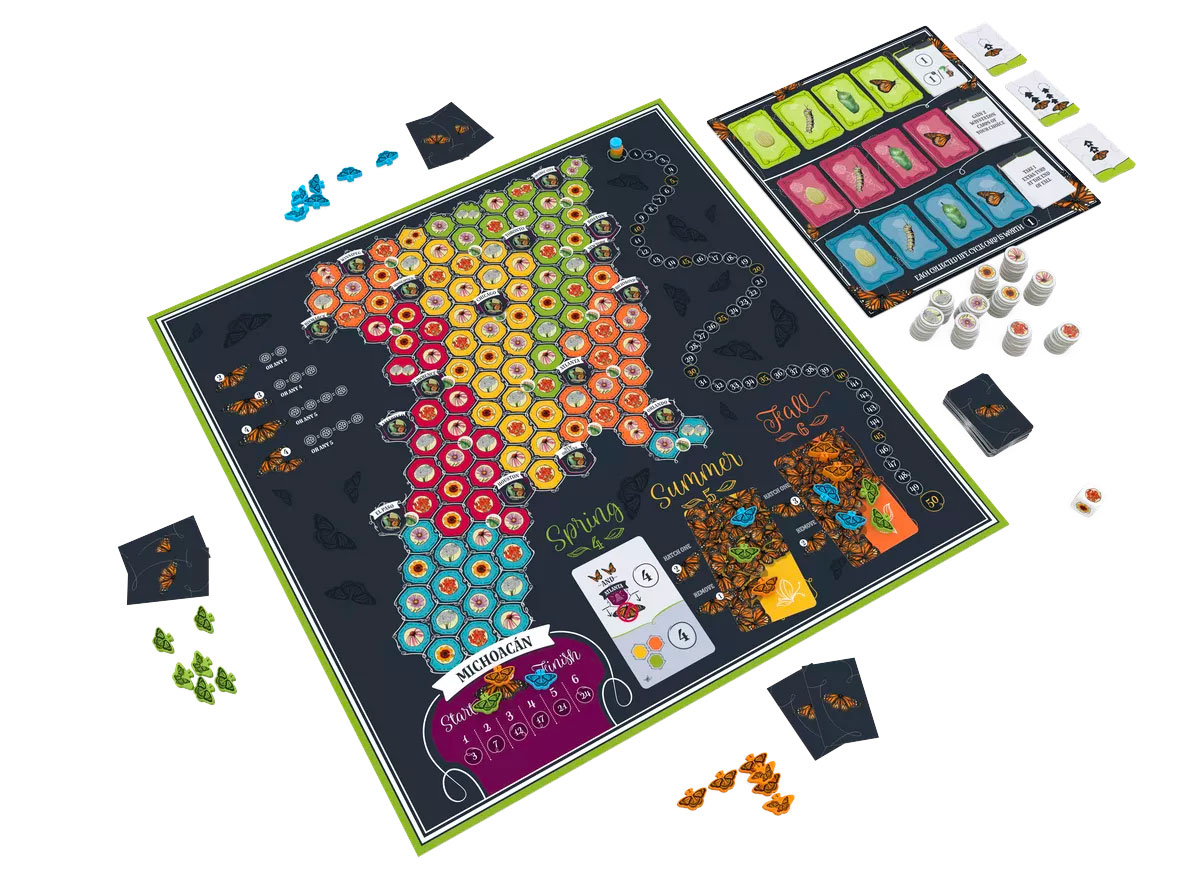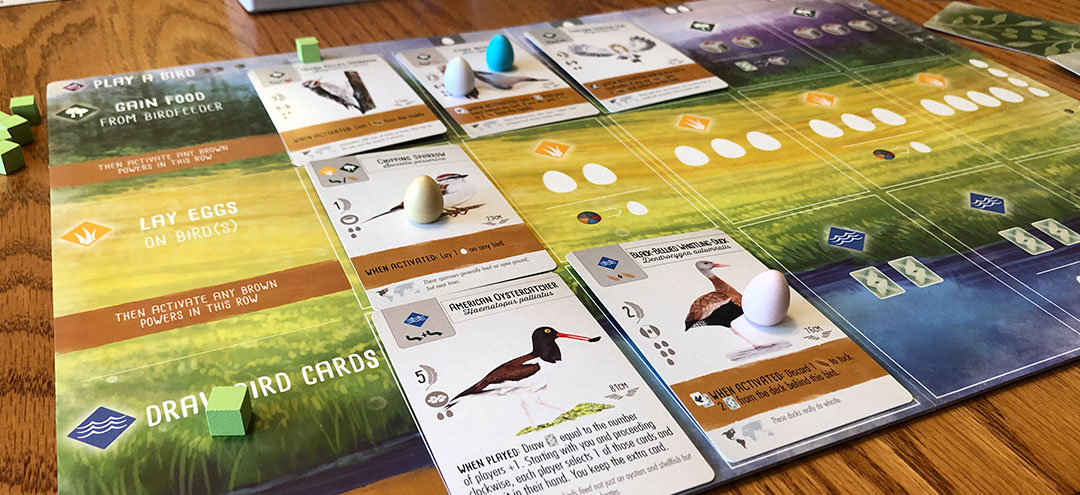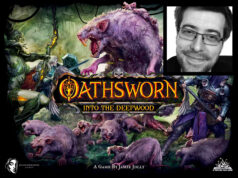 There could be no better moment to have an informal chat with the talented designer
There could be no better moment to have an informal chat with the talented designer
Elizabeth Hargrave, who created Wingspan.
Elizabeth Hargrave games, Tussie Mussie, Mariposas, and Wingspan, are widely regarded as examples of great talent as a game designer.
I hope you enjoy the interview as much as I have enjoyed having a friendly chat with Elizabeth.
Why did you choose to go into board game design? How did it impact your career and personal life?
I first decided to start designing a game because of a specific conversation with some friends where we talked about the themes of the games we were playing and how none of the themes was really about topics that interested us. Then my husband said, “what if there was a Race for the Galaxy but with birds?”. We were playing a lot of Race for the Galaxy at the time. Then my brain just grabbed onto that idea. So, I started brainstorming and playing cards against myself, and for a long time, it was just a side thing, a hobby, which I think is true for most game designers. You definitely can’t just quit your day job because you’re working at a board game. Even for people that are successfully published designers, it is just not enough of an income stream to make it your day job. Because Wingspan was so successful, I did eventually quit my day job. I was doing consulting work before and was freelance, so I had some control over my schedule. I was able to work around conferences and things.
It didn’t impact much in my personal life. It’s a different type of work, but I don’t always feel I have more control than before. There are lots of events that I think I should attend. There are a lot of things that I have to do to support my games, and I have to do these things. In any money-making endeavor, there will be things that you enjoy doing and things that feel like obligations. That’s fine. All the time we spend testing games, for example, feels like a zero-sum. You are not just playing games; if you have a limited number of people to play with, you can do one or the other.
What inspires you to design a new game? Can you briefly describe your creative process of developing a new game?
Usually, I feel like there is something in the world that I think is so cool that I want people to know about it. And I can imagine how the core mechanics of a game should be to get that idea across.
With Wingspan, as I said, the initial idea was to create a sort of Race for the Galaxy, but with birds. And then, it strayed from being a complete replica of a Race for the Galaxy, but it maintained that sort of engine-building feel.
A lot of it starts with that initial inspiration, then trying to make something I strongly believe in, and getting some draft version of the game to the table as quickly as possible. I don’t spend much time thinking about it or making every card perfect. I make a bunch of cards and see how it works; then I iterate over and over, and as you playtest, you make it better.
It gets to a point when the changes you’re making are minimal, and it’s essential to catch the little nit-picky things that aren’t quite right yet.
I don’t enjoy playing and testing board games online, so I don’t. You can only imagine what a game could be like if played for real. And I think playtesting online leads to specific design decisions that might be different than if you played live. I’ve seen cases where someone created a game online, then printed it out to play in person, and discovered that they didn’t realize how big everything was. The table is as big as you want it to be on the online play and testing. Size doesn’t matter, and you can reach everything. As I can design and test my games in person, that’s the way I like doing it.
Do you play your games?
I don’t play my games often, but sometimes, I may have an opportunity to play or teach my games.
For example, this summer, I got invited to a birding festival and participated in a workshop for people to learn how to play Wingspan. Did I play there? I think so. I play with friends every once in a while, but not very much. However, most times, I’m just teaching.
Out of the games you designed, which one is your favorite to play?
I can’t pick a favorite. But I can’t deny that Wingspan had something special; if I knew what that was, I would do it repeatedly.
Do you think that the game industry has changed from when you started working on games in 2014 and realized that games were very limited in their theme (like adventure games) and mechanics? Where do you see the game industry five years from now?
Currently, producers are in a tough spot because shipping is much more expensive than it should be. We’re shipping things around the world that shouldn’t have a high cost, which is also environmental. But, honestly, I am pleased not to have to worry about that side of the whole planning process because it’s overwhelming. And I think it’s very stressful for a lot of the publishers right now. I feel for them; it’s customers and publishers who have a specific set of expectations. For example, I think Amazon has set people’s expectations that you should be able to ship something for free, but board games are heavy; they cost money to get places, like fuel.
I don’t know the answer; shipping prices first spiked during the pandemic. Many people started asking, why aren’t we making some of these games in the United States? And from what I’ve heard, the answer is that even with the high shipping costs, it’s still cheaper than to do them overseas. I don’t know if the issue might change if people can figure it out.
Your games are about conservation and hopeful evolution. Would you consider a game about reintroducing extinct animal(s)? What would they be?”
Oh, my goodness. I know some people are thinking about this. And should we bring back the closest possible relative? Like there used to be some version of camels in North America, should we get some camels to North America so that they fill the niche that used to be here? I don’t know. In North America, there’s a tree whose seeds are enormous, and they think a giant sloth once spread it. That would be fun to play with giant slots.
Any hints on what we can expect for your future games (it is known from the news that you are working on a game about mushrooms, for example)?
Yes. I’m working on compact experiments on Kickstarter. Next up will be the Asia expansion for Wingspan coming out this fall. And then, sometime next year, I’ll publish my mushroom game; I think it will be on Kickstarter and will likely be produced with AEG. It’s getting there. And it’s about the relationship between trees and mushrooms and the fact that they trade nutrients through their roots.
The board is made of different mushroom species, and you’re playing from the perspective of a tree. You’re trying to get your seedlings out in the world, so you’re paying carbon to the mushrooms, which give you nitrogen, phosphorus, and potassium back for your carbon. You can then use those resources to put out new seedlings or new roots and grow your whole system of mushrooms.
There is some engine building mechanics. I need to figure out how to articulate the game mechanics so that in the game, players are building their system of mushrooms from a shared board where they can put out more mushroom species. And it’s not quite a worker placement game, but it feels a bit like worker placement because you have a limited amount of carbon you can spend to get the things you need. Allocating carbon to the mushrooms may block other players because each mushroom can only have a certain number of trees around it. So, you’re fighting over a map a little bit, but not fighting in the sense that you can never kick someone out of their spot. However, once a tree is where it remains in place.
When I design games, I prefer focusing on one game until completion instead of working on parallel games. But I’m also working with a co-designer. Last year, we were working together, and it all started coming together. And while I had handed it off, I started working on the mushroom game. Suddenly everything was happening all at once, including the Asian expansion for Wingspan. I was working on three things, and that was too much. But I’ll probably start working on the next wingspan expansion once I start wrapping up the mushroom game.
Can you briefly describe the experience of going from playing with friends; to getting inspired to design games based on themes from nature; to designing Wingspan; pitching the game to publishers; producing and releasing the game; receiving critical acclaim and appraisals; winning the 2019 Kennerspiel des Jahres; and ultimately, Wingspan becoming a worldwide phenomenon.
Even the first week that Wingspan came out, it was popular. The copies Stonemaier had printed and had available to sell directly sold almost immediately. The games they sent to retail were not enough to fill the stores’ waitlist. And they spent the rest of 2019 trying to catch up on copies to fill the demand. They just had no idea that it would take off as it did. Even before the Kennerspiel prize, they continuously had problems printing enough copies. And the Kennerspiel just made it worse “in a good way”. We don’t know what would have happened if all the pieces hadn’t fallen into place. But, even at the beginning of 2019, it was beyond my wildest expectations.
When I got nominated for the Kennerspiel and went to Berlin, I quickly noticed that was one time I could not do my previous work and be a game designer. I’m going to all these conferences and all this traveling. That was 2019, and we weren’t doing any travel the following year.
What do you think about diversity in the board games market, and even diversity being expressed in board game design?
Yeah, I think it’s essential to pay attention to it. And I think it is being represented to a certain amount. There’s a feedback loop that for a long time, it was primarily European white guys making games, and they made games that interested them. And those games attracted people that were like them. And so, for a long time, I think people in the industry have assumed that board games appeal to a specific demographic and that you shouldn’t try too hard to reach outside of that demographic.
Because this is just how it was done, these were the people interested in board games. Then I think what people realized more and more is that if you envision a world where it’s possible that anyone would like to play board games, you can make games that are inviting to a broader audience. And the feedback loop can be that if you make those games that are inviting to a wider audience, then more different types of people will play those games. And then the population of designers always comes out of the population of gamers. So, if you get a more diverse population of gamers, you will have more diversity-oriented designers. And they will turn around and make games from lots of different perspectives. And those perspectives will appeal to lots of different people. And I think we’re already starting to see some of that happening.
At one point, Stonemaier shared the demographic breakdown of their different Facebook groups for their games. And the Facebook group for Wingspan was dramatically different from their other games. It’s very close to 50/50, male and female. There’s always, you know, a few percentage of people who don’t identify as either, but you now have all these women finding games that they enjoy playing. And they’re finding game groups that they find welcoming. All I’m saying also goes for people of color, right? It is the same dynamics; if you are playing a lot of games that only portray white European people, that may be less inviting than when you see games that show all kinds of different people on skin tones.
Regarding gender, we don’t have to force all couples to be male or female, and it’s not essential to attach play and gender.
Even though I haven’t played, I hear that Netrunner is an example where they went out of their way to represent the diversity of the gender spectrum. I think it all depends on the game. You may not have much more story around someone’s relationship than, like, these two cards go together. Right? So, it depends on whether the game can embrace diversity. Fog of Love did a separate box cover showing same-sex couples versus opposite-sex couples. So, they tried to embrace the idea that you could play the Fog of Love from any perspective.
That’s an exciting topic, and I think it’s something people are more aware of going forward. We’ll see, and I hope so.

You design games that can appeal to family-friendly or advanced gamer audiences. How do you choose what type of game you want to develop? Do you prefer to create for a specific audience?
That’s a good question. I like doing a mix. Partly it’s on the theme. I felt like in Mariposas, and with the butterflies, it would be something that should be more family-friendly. So, I didn’t want it to be too heavy.
Tussie Mussie was designed to have 18 cards only. It’s hard to get too heavy. So, it is quite like it’s probably the lightest one.
With my mushroom game, it’s going to be more than that. Maybe a little heavier than Wingspan somewhere in that range. So that’s probably my sweet spot, like Wingspan or a little “heavier-ish” is the weight I play as a gamer.
I do try to articulate at the beginning of the process of designing a game. What would feel right in terms of game mechanics? What is working? Who do I think would play the game? Where do I want it to be on the scale, between light or heavy? Sometimes, the game changes my mind when I’m playing. I’ll decide, oh, it’s okay to be a little bit heavier because that’s how this is, and it’s working well like this.
Do you think Wingspan changed the game industry?
For any game that is out now, the designer likely started working on it before Wingspan came out.
It happens that there are trends in which people are more interested.
I think that pandemic made people more interested in nature because we all felt cooped up in our houses. And we wanted to go outside.
So, from a marketing perspective, I think there were reasons publishers were also more interested in games about nature that were not only Wingspan.
But I think Wingspan didn’t print enough copies to meet demand initially because of the distributors’ feedback. The publisher asked their distributors how many copies we should print for this game about birds, you know, from a first-time designer, and the distributors thought they wouldn’t be able to sell many copies.
So, I think that Wingspan proved that you could sell many copies of a theme that you might not think would be popular. And I hope that that makes some publishers more adventurous.
I think Kickstarter also makes publishers more adventurous. Because the bit the point of risk right is you must pay the manufacturer to make games before you sell them. And Kickstarter flips that and allows you to find out how much demand there is for a game before deciding how many copies you print. So, I think that makes some publishers more willing to take a risk. Of course, there are a lot of costs, even developing the game and getting all the art before you can run the Kickstarter, so it’s not without risk, but it’s less risk than if you pay to make 10,000 copies of something that’s not going to sell.
And I hope that that makes some publishers more adventurous
I see many two-player games coming out in the next few years that started during the pandemic.

What is it like working for a different game producer?
Every one of my games has been from a different publisher, and everyone has been different. I think that’s pretty common because it depends if the publisher wants to do your game, right? There are very few designers that work with the same publisher. I will happily do another game with the publishers I’ve worked with. But when I, for example, started working on my Mariposas, I think the company was still pretty much just Jamey. And Wingspan was taking over his entire company. And with Mariposas and Tussie Mussie, it was a particular story.
With Mariposas, I submitted to AEG precisely because they did a call for designs from women. And this was before Wingspan had come out, so I thought that it was cool that they wanted to diversify, but at that time, they did not have any women in their catalog. And I appreciated that they were trying, and I was like, oh, I’ll throw a design. And it was not ready yet. But I sent them what I had and said, you know, this is what I would do next. So, before Wingspan came out, they played Mariposas and wanted to sign it. So, I had no idea that Wingspan would be a hit. Neither did they. But we found each other.
With Stonemaier, I saw what he was doing and wanted to participate.
Testing Tussie Mussie was the same. It was well; it’s 18 cards. So, Stonemaier would never do that. But it was designed on a whim for an 18-cards contest by Button Shy. I’m sure Love Letter inspired Button Shy as a company; their entire product line is only 18 card games.
Your games present diverse game mechanics while still being extremely original. How did you learn to be a game designer and expert in various game mechanisms?
It is funny because it doesn’t feel as unique and novel to me anymore when I play and test games so many times. Yeah, I’ve done it, so it’s fun to hear what people think it feels.
Thank you, Elizabeth Hargrave, for the lovely interview! We are looking forward to playing with your future games soon!






















